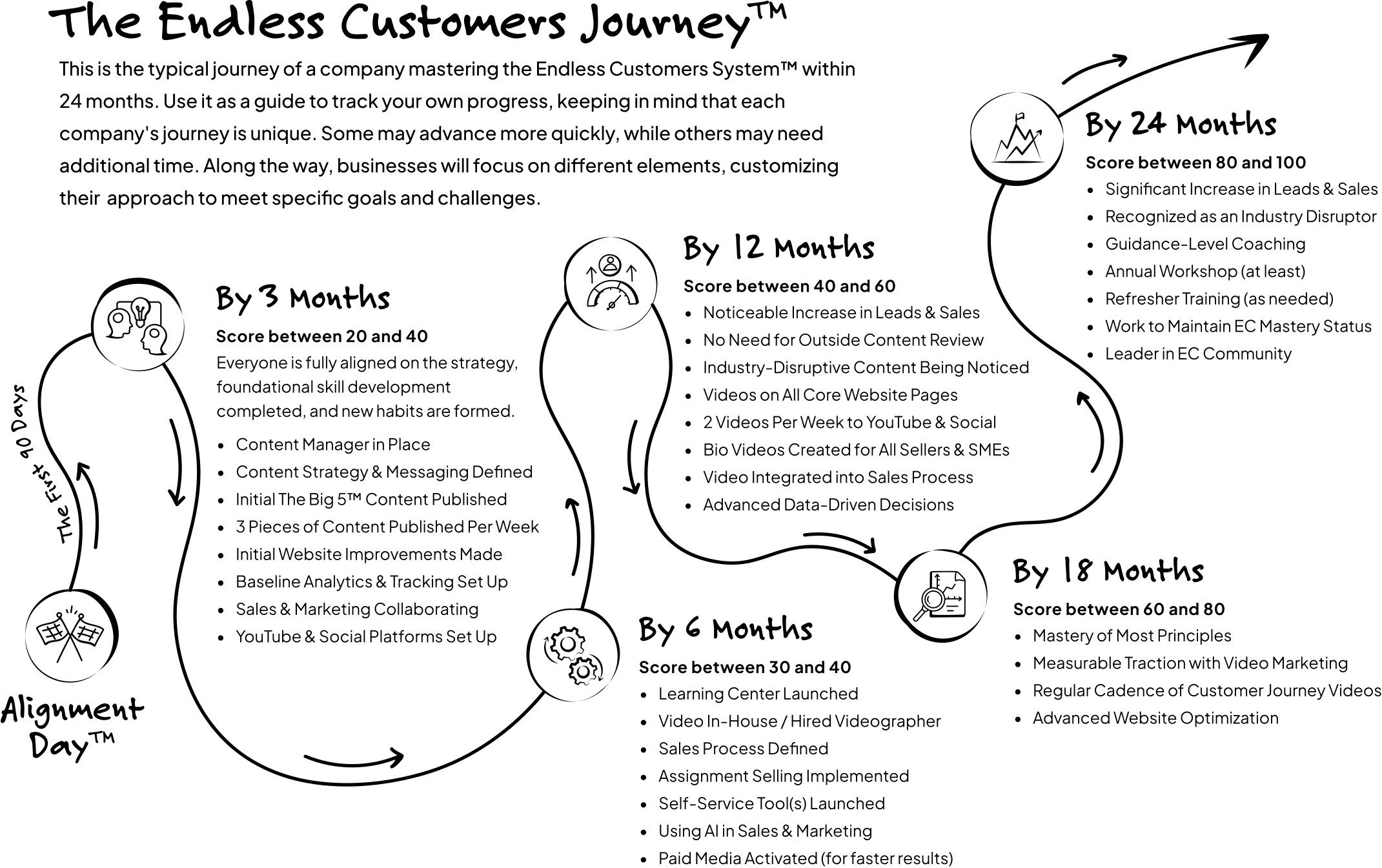- Learning Center
- Endless Customers Fundamentals
- What Is the Typical Endless Customers Journey?
- What Is the Typical Endless Customers Journey?
-
Search
What Is the Typical Endless Customers Journey?
Last updated on October 13, 2025

Most breakdowns within an organization don’t start with bad strategy. They start when sales, marketing, and leadership stop speaking the same language.
Marketing creates content no one uses. Sales skips what marketing builds. Leadership tries to fix it all in a quarterly off-site. Meanwhile, buyers slip through the cracks; unconvinced, unclear, and long gone by the time someone notices.
The Endless Customers Journey fixes that.
It’s a proven system used by hundreds of companies to align their teams, shorten their sales cycles, and become the most trusted brand in their industry.
The journey unfolds in five phases. Each one brings new habits, new expectations, and new results. And while most teams reach full momentum in 18 to 24 months, the ones who win aren’t the fastest, they’re the most consistent.
In this article, you’ll learn what the journey looks like, how progress is measured, and what it takes to keep your team moving forward, together.
Why the Typical Endless Customers Journey Matters for Growth
Most companies are stuck in a cycle of trial-and-error sales and marketing. Siloed teams. Content no one uses. Buyers who bounce because they don’t trust what they see.
Up to 95% of marketing content goes unused by sales teams. That’s not just a waste, it’s a warning sign. It tells you your teams aren’t aligned, your buyers aren’t convinced, and your strategy isn’t working.
The Endless Customers Journey fixes that. It aligns leadership, sales, and marketing around one shared mission: building buyer trust. And it gives you the roadmap and scorecard to see what’s actually working, and what’s just noise.
“Alignment isn’t a soft skill. It’s a growth lever. When sales, marketing, and leadership are aligned around trust, content becomes the most powerful growth engine in the business.” - Endless Customers
What the Typical Endless Customers Journey Involves
The Endless Customers Journey is about building new habits that stick. Each phase is designed to move your team closer to full alignment, sales enablement, and deep cultural trust.
It starts by removing the friction between departments, between tools, and between your company and its buyers. Then it reinforces new ways of thinking: publishing with purpose, measuring what matters, and treating trust like a team sport.
Every quarter, your team comes together for a strategic planning session. These meetings do more than shuffle priorities, they reset expectations, re-center the mission, and ensure that strategic clarity turns into operational consistency.
That’s how Endless Customers becomes more than a marketing effort. It becomes how you work.
The 5 Phases of the Endless Customers Journey
Each phase includes core milestones, common blockers, and mindset shifts. Score ranges below reflect progress levels from the Endless Customers Scorecard.
Phase 1: Awareness and Alignment
Timeframe: Month 0–3
Score Range: 20–40
This is where the journey begins. Phase 1 is all about waking up to the disconnect. Leadership is committed to growth, but teams are misaligned. Sales isn’t using content. Marketing isn’t sure what to create. Everyone’s busy, but nothing’s moving.
Alignment Day is the turning point. This session creates the shared language, clarity, and commitment your team needs to move forward as one. It sets the tone for everything that follows.
By the end of Phase 1, your team has finished planning and started producing. You’ve named the buyer questions that matter most, started creating content that answers them, and seen your first signs of traction.
Early Wins (Buyer-Facing):
- Big 5 content begins ranking and generating organic traffic
- Sales starts assigning content to buyers
- Website starts shifting from brochure to buyer tool
- First signs of improved sales confidence and shortened cycles
What Progress Looks Like:
- Your team understands the new rules of buyer behavior
- Everyone speaks the same language around trust, transparency, and content
- Content production is happening consistently, not sporadically
- Sales starts showing up to content conversations with input instead of resistance
Phase 1 isn’t about more than understanding the strategy, it’s about building early proof that the system works. Alignment turns theory into action and gets your momentum moving in the right direction.
Phase 2: Content Creation + Sales Enablement
Timeframe: Month 3–6
Score Range: 30–50
This is where the strategy turns into action. Content is showing up on your site, in sales emails, and real conversations with buyers.
You’ve identified the questions buyers ask most. Now you’re answering them, clearly, consistently, and in your voice. Sales is starting to assign content before calls. Marketing is writing with purpose, not guesswork.
The organization is starting to feel different. More confident. More proactive. Less reactive.
Early Wins:
- Sales uses content to answer objections before calls
- Learning Center launches or expands
- Traffic increases from pricing, comparison, and problem-based content
- CRM starts showing attribution from key pieces
What Progress Looks Like:
- Content maps directly to stages in the buyer journey
- Sales shares feedback and requests new articles
- Marketing publishes consistently, tied to real questions
- Teams begin to see content as a revenue tool, not a marketing task
This is when the work starts, well, working. You’re not just publishing content, you’re attracting better buyers, having smarter conversations, and building a system that brings in customers, week after week, quarter after quarter.
Phase 3: Scorecard Accountability
Timeframe: Month 6–12
Score Range: 40–60
Phase 3 is where accountability takes root. The excitement of early wins gives way to rhythm, consistency, and tracking what’s actually moving the needle.
The scorecard keeps the work visible. The team knows what matters each quarter and how to track progress. Content isn’t an extra task but a visible part of how the business grows.
Sales and marketing are sharing goals, language, and results. The walls between them are coming down.
Early Wins:
- Buyers arrive already educated from your content
- Sales cycles get shorter and more predictable
- Sales teams proactively request and assign articles
- Attribution tools show content contributing to revenue
What Progress Looks Like:
- Weekly scorecard reviews drive real adjustments
- Team reviews content performance against real deals
- Everyone has visibility into what’s working and what’s not
This is where consistency compounds. The metrics are visible. The team knows what to do. And results start to feel repeatable.
Phase 4: Teamwide Adoption and Internal Development
Timeframe: Month 12–18
Score Range: 60–80
At this point, the new culture starts to take over. The system no longer feels new. It feels normal. Content strategy, sales enablement, and trust-building aren’t confined to a few people or one department, they’re becoming part of how the entire company operates.
New voices start contributing to the content engine. Sales leaders reference Big 5 articles in team huddles. The flywheel is turning, and more people want to be part of it.
Early Wins:
- Subject matter experts contribute to articles and videos
- Sales team uses content in every stage of the funnel
- Buyers comment on content in discovery calls
- Messaging across teams becomes clearer and more consistent
What Progress Looks Like:
- Trust-first thinking shows up beyond sales and marketing
Content becomes part of onboarding and training - Teams proactively bring new ideas to the table
- Internal resistance drops, ownership rises
Behaviors that once required outside nudging or leadership oversight are now owned across the team. The strategy becomes culture. The mission is internalized. You don’t need to push anymore; your people pull.
Phase 5: Scaling and Strategic Leadership
Timeframe: Month 18–24
Score Range: 80–100
This is where growth becomes sustainable. The system is no longer in test mode. It’s trusted, proven, and scalable. Teams aren’t just following a strategy, they’re owning it. The business runs on clarity, accountability, and a shared mission rooted in buyer trust.
New departments adopt the mindset. Sales leaders coach to it. Marketing teams don’t need to be told what to write, they’re in the field, listening, and publishing consistently. Leadership has moved from alignment to acceleration.
The goal here isn’t perfection. It’s repeatability. That’s what makes the system durable, and the growth dependable.
Early Wins:
- Buyers echo your content language in calls and emails
- Sales cycle speeds up across teams and segments
- Industry peers reference your content as a standard
- Brand becomes synonymous with clarity and transparency
What Progress Looks Like:
- Leadership communicates through the lens of buyer trust
- New team members are onboarded into a trust-first culture
- Sales and marketing performance is measured against the scorecard
- The strategy scales across teams, markets, and even brands
This is when trust-first thinking is embedded in leadership communication, onboarding, hiring, sales, and marketing. It’s no longer an initiative. It’s how the business thinks and operates.

What Success Looks Like
Success is when your team isn’t waiting for direction, they’re owning the mission.
Sales and marketing operate from the same playbook, with content that shortens the sales cycle and drives real revenue.
Your website doesn’t just attract traffic, it answers your buyers’ hardest questions better than your competitors do.
Leadership has clear visibility into what’s working, what’s not, and where to focus next. Guesswork is replaced by insight. Alignment isn’t an event, it’s the norm.
“When sales doesn’t trust marketing, content dies on the vine. When buyers don’t trust your content, deals stall out. Trust isn’t just the goal, it’s the fuel.”
— Endless Customers
Want to Get Started on Your Journey?
Implementing Endless Customers is about changing how your team thinks, sells, and grows together.
We've found that the businesses who do the best take full advantage of our Endless Customer coaches.
Endless Customer coaches are focused, persistent, and obsessed with one outcome: helping you become the most known and trusted brand in your space.
Get started with a coach today.

This article was produced as a collective effort of the IMPACT Team and is regularly updated.
Endless Customers Fundamentals
What Is the Typical Endless Customers Journey?
Share
READY TO IMPLEMENT ENDLESS CUSTOMERS™ IN YOUR BUSINESS?
You’ve learned the philosophy. Now it’s time to put it into action. Our coaches will help you apply the Endless Customers System™ to your sales and marketing so you can build trust faster, close deals sooner, and create a steady flow of new customers.
READY TO IMPLEMENT ENDLESS CUSTOMERS™ IN YOUR BUSINESS?
You’ve learned the philosophy. Now it’s time to put it into action. Our coaches will help you apply the Endless Customers System™ to your sales and marketing so you can build trust faster, close deals sooner, and create a steady flow of new customers.